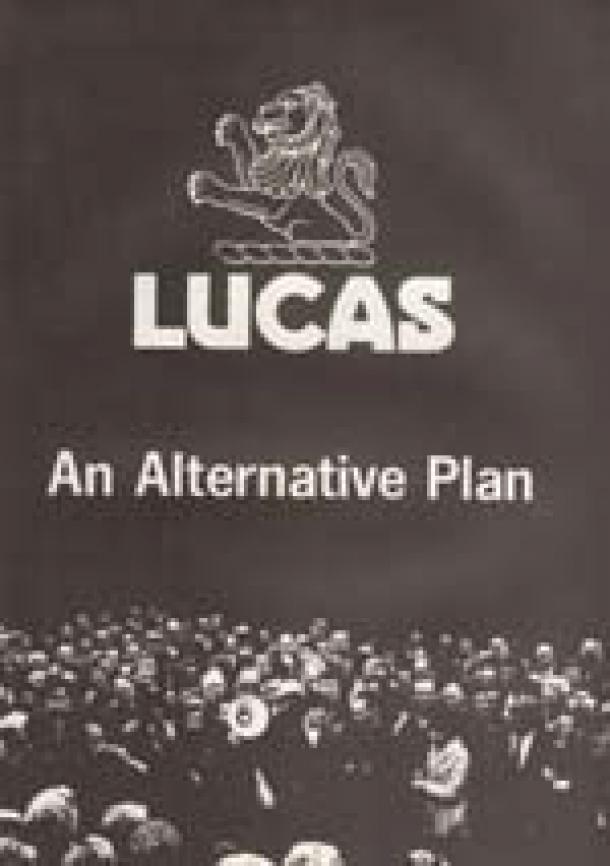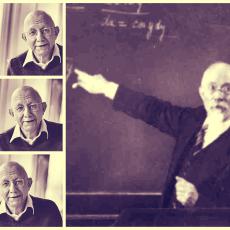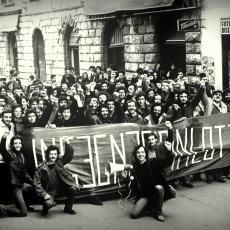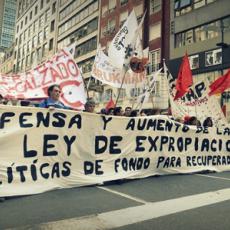1976: The fight for useful work at Lucas Aerospace
History of how arms company workers struggled against closure and for a change in their work from weapons manufacture to socially useful production.
In the 1970s workers at the Lucas Aerospace Company in Britain set out to defeat the bosses plans to axe jobs. They produced their own alternative "Corporate Plan" for the company's future. In doing so they attacked some of the underlying priorities of capitalism. Their proposals were radical, arguing for an end to the wasteful production of military goods and for people’s needs to be put before the owners’ profits.Military Matters
Lucas Aerospace in the early 70s was one of Europe's largest designers and manufacturers of aircraft systems and equipment. It had over 18,000 workers on its payroll, spread over 15 factories, throughout Britain. Nearly half of its business was related to military matters - in production of combat aircraft and the Sting Ray missile system for NATO (pictured, above). But it also had small interests in medical technologies.
The company had been formed into the size it was through the take-overs and amalgamations of smaller size companies. It had been backed by the Government of the day who wanted a strong and efficient aerospace company to compete with the other European manufacturers. As part of achieving this Management planned to rationalise the whole 15-factory operation into a more integrated and streamlined company. This would mean lay-offs for at least 20% of the workforce and the closure of some areas. The prize for the owners of Lucas in doing this would be a much greater involvement in the military markets where profit rates were very high compared with other industries.
Poor Wages
The intentions of the company owners and management did not go unnoticed by the Lucas workers or their Shop Stewards Combine Committee (SSCC). The origins of the SSCC was in the strong trade union tradition at the time in Britain though particularly in the aerospace industry. Over a period of years the workers in the different unions had seen the need to co-ordinate their negotiations against a single management so as to avoid poor wage increases as one section was paid off at the expense of the others. So they formed shop stewards committees that bridged their different union memberships. As the company had grown bigger these shop steward committees from different areas also linked up to carry on the same idea of meeting the management with a single voice for all workers in any negotiations.
Struggle pays
The SSCC at Lucas which linked all the company sites had not, however, come about without much effort or struggle. It had grown to the importance it had because of its involvement with the direct rank and file struggles of workers there and was looked to by many far more than their individual unions or full time union officials. One of the most spectacular successes of the SSCC was in the Burnley strike in 1972 when by means of mobilising the support of all Lucas workers, a 13 week strike by Burnley workers was carried to a successful conclusion leading to a wage increase 167% larger than that nationally negotiated by the union officials! The SSCC in the course of the strike had organised widespread collections and support meetings for the striking workers and had backed this up with strategic work stoppages at different plants that had maximised the losses to the company with the minimum loss in pay. The support action co-ordinated by the SSCC was extremely effective and eventually saw management capitulating despite their previous claim that they wouldn't give the workers a penny extra.
After the Burnley strike, the SSCC was able to achieve much better pay and conditions for all union workers at Lucas. Local disputes in the company were often settled through sympathy action co-ordinated by the SSCC. Management was unable to break the new-found unity and was fearful of any large strike, like that at Burnley, breaking out again.
Useful jobs
It was against this background that the SSCC in 1976 proposed the alternative Corporate Plan (below) to Lucas's management.
It was the product of two years planning and debate among Lucas workers. Everyone from unionised engineers, to technicians to production workers and secretaries was involved in drawing it up. It was based on detailed information on the machinery and equipment that all Lucas sites had, as well as the type of skills that were in the company. Its central aim was to head off Lucas's planned job cuts by arguing that the concentration on military goods and markets was neither the best use of resources nor in itself desirable. It argued that if Lucas was to look away from military production it could expand into markets for "socially useful" goods where it already had some expertise and sales.
If this was done no job losses would be needed. The Plan itself did considerable market research for what was needed to replace the military goods and what Lucas could actually make. According to it Lucas could eventually wind down its military production, keeping all its present workforce. In other words no job losses at all were envisaged. Moreover, the production of high technology equipment like kidney dialysis machines would be of far more benefit than Sting-Ray missiles to society. The workforce would be much more happy with this from the point of view of jobs and the quality of work.
Shunned by bosses
Lucas's owners and management did not however place a very high value on either the provision of work or its quality. When the Plan was presented to them they shunned it. They resented "their workers telling them what to do" and insisted on the Company's commitment to defence production. The job cuts and rationalisations were to continue.
...and union leaders
The full time union officials half-heartedly pledged their support for the Plan, but did nothing to widen the support among other trade unionists for it. This partly reflected their antagonism to the radical proposals of the Plan which went outside, by a long stretch, the cosy wage negotiations they were used to. But also they were antagonistic to the SSCC which they saw as getting above its station. They were worried that the influence of the SSCC and the hornets’ nest it was stirring about job cuts and "socially useful" production might spread beyond their control even more than it already had. Maintaining the status quo was particularly important to them also at this time because of the pact signed between the Union leaders and the Labour Party Government which was aimed at taming the demands of union members in return for more say for the Union bosses in "national policy".
Sell out
The Labour Party similarly, now forming the Government, applauded the Plan but spent their time avoiding it like the plague. It reflected some of the weak politics, however, of the SSCC that they had turned to them at all. It was the British Government (with active Labour Party involvement) which in the first instance had supported Lucas's move to a competitive military manufacturer for NATO. Like all "socialists" in Government they had promptly forgotten their commitment to help the workers’ movement.
Direct action
If it was direct industrial action that had built the SSCC into what it was and gave it the confidence to produce the likes of the alternative Corporate Plan, then it would have been the same industrial action that would have carried it forward further. That such direct action by the workers was not looked to by the SSCC in the aftermath of its rejection by the Lucas bosses reflected major weaknesses. Looking to the Labour Party was a huge weakness since it presupposed that Labour really had the interests of the workers at heart, which it didn't. The Labour Party in Government was looking after the interests of the British state. It was not going to challenge capitalism - or its values - which the Lucas Plan did at root. Workers, as became clear, only had themselves to look to for help. If the SSCC looked to this they may have got somewhere.
To some this response of management's was not very surprising. But these people were in the minority. The bulk of the SSCC while expecting an argument and some tough negotiations were totally taken aback at the response. As one AUEW shop steward put it: "Quite honestly, I thought the Company would have welcomed it... that they would see it as constructive trade unionism... ".
Profits first
Constructive it may have been if the world was being run along different lines - ones that valued people’s need for meaningful work and put social needs above military production. The company's owners were adamant that this wasn't the way things were going to be. For them capitalism was the order of the day and this meant profits first and foremost. Moreover it was their right to "manage” Lucas and to decide where its resources would be used. To them the 18,000 people working at Lucas had no say in these fundamental matters. In the aftermath of the Lucas Plan they determined to break the SSCC and its influence, which as we will see they did.
Labour Party
If the rejection of the Plan came as a surprise to the SSCC, the aftermath put them in a spot - what to do next. Previous to this when management had stalled or rejected their demands they had returned the matter to the rank and file workers where industrial action of some sort had been used to shift the company. But this time, this did not happen. Instead the SSCC turned their attention to winning the Labour Party and the full-time Union officials to their cause. In doing this, they spent less and less time in consultation with the workforce at Lucas. The workers there who would have had the most to fight for and to gain from the Plan became less informed. Even the regular news-sheet previously produced by SSCC became more and more irregular, eventually disappearing altogether, Slowly the unity built up in previous times was whittled away as SSCC members were now spending a huge degree of time meeting Labour MPs and Ministers - neglecting the real job of maintaining their workplace organisation.
Job cuts
As the lobbying of Labour Party MPs and Union bosses continued, Lucas's management proceeded with the job cuts and rationalisations where they could. With the SSCC busy lobbying but not co-ordinating any action, unity weakened among the workforce. Different areas were left to fend for themselves. With this situation Management did have the upper hand and used it. Some local victories were won by workers and jobs saved. Mainly this was through industrial action of some sort to force implementation of parts of the Plan. But this situation was a poor replacement for the unity and strength of previous times. Inevitably when jobs went, activists and in particular some of the main workers behind the SSCC were victimised. Once again, as has too often happened in Britain, faith in the Labour Party was a slippery slope to being sold out and losing the fight, Lucas workers had got to where they had through their own actions and organising capacity - it was this that would have been the way forward.
The Alternative Plan - What the Lucas plan proposed
What was the alternative Lucas Corporate Plan? Over a period of two years a series of proposals that later became known as the Lucas Plan were drawn together through the active involvement of most of the workers in the 15 different Lucas factories. Its aim was to shift Lucas Aerospace, as a company away from the production of military goods, mainly for NATO (an emphasis that was capital intensive and had high profit margins for Lucas's owners) and towards the production of socially useful goods (which was a labour intensive field, relying more on the skills already in the Lucas Company). Such a shift would mean the preservation of jobs at Lucas and the fulfilment of some of the more pressing needs of society. Here is what was proposed:
Medical Equipment:
- Increase production of kidney dialysis machines by 40% and look into the development of a portable model.
- Build up a 'design for the disabled' unit, with the Ministry of Health, to look into things like artificial limb control systems (which could use Lucas's control engineering expertise), sight aids for the blind, developing the 'Hobcart'. This vehicle was designed in the 1970s by an apprentice at Lucas to give mobility to children suffering from Spina Bifida. Lucas management had refused to develop it on the grounds that it was incompatible with their product range.
- Manufacture an improved life-support system for ambulances. An ex-Lucas engineer turned doctor had offered to help design and build a prototype for this, using a simple heat exchanger and pumping system.
Alternative Energy Techniques:
Due to the finite availability of fuels like coal and petrol, they proposed that Lucas concentrate on renewable sources of energy generation and developing more efficient methods of energy conservation from fuel sources. Up to 60% of energy is lost with traditional forms of its use (car engines etc.). Moreover this would provide a real alternative to nuclear power generation which was unsafe and damaging to the environment.
- Development and production of heat pumps which were efficient in saving waste heat. Such heat pumps would be used in new housing schemes to provide a very cheap service.
- Development and production of solar cells and fuel cells.
- Development of windmills. Lucas's experience in aerodynamics would be invaluable.
- Development of a flexible power pack, which could easily adjust to people's situations allowing for small scale electricity generation using basic raw materials. Such instruments would be invaluable in under-developed countries where electricity provision is very poor.
Transportation:
- The development of a road-rail public transportation vehicle which would be light-weight using pneumatic tyres on rails. Such a system would be cheaper, safer for use and more integrated. It would allow rail services to be provided in areas where they were being closed down, etc. The road-rail vehicle would be able to travel on rails mainly but also convert to road use when needed.
- A combined internal combustion engine/battery powered car which could give up to 50% fuel savings while reducing toxic emission from cars.
The Plan proposed various other ideas in the areas of braking systems, undersea exploration technology and remote control devices.
The thrust of the Lucas Plan was radical from the beginning. It asked basic questions like what was the real use of Sting Ray missiles and high technology fighter aeroplanes to society. Their production gobbled up money resources and technical inventiveness, making those who owned the Companies richer and richer but society got nothing from them.
Waste
Basic needs in society are only filled inadequately, like for instance kidney dialysis machines, whose general shortage in society was then and still is a crying shame. Lucas, its workers argued, had the expertise to develop better, smaller and more mobile units which kidney sufferers were crying out for. Why shouldn't they do so?
Worse still, under a system that produces high quantities of weapons and armaments, not only is money wasted but also much human technology and innovation is wasted or misused as well. Take the proposal by the Lucas workers that the sophisticated radar systems used in modern fighter planes be used in the development of an "alternative sight" aid for blind people. Such a thing is easily within human capabilities, but is not made or even developed as a priority now.
Under capitalism the world's resources and wealth is owned and used to make profit for the wealthy. Most money is invested where profit is highest. The fulfilment of human needs is always a secondary priority The Lucas Plan challenged many of the basic assumptions of capitalism: why should profits come before people? What value have military goods in a world with so many other pressing needs? As such it was important. But far more fundamentally it showed what capacity workers have to articulate their priorities and their values.
Anarchism
For the future it showed what enormous potential a society based on socialism could have. Such a society with real workplace democracy and the participation of all in the management of society would allow for the creative capacity of each individual to have its say while the real needs of society are met. But for this to be achieved as the Lucas workers learned, capitalism and its priorities must be overthrown.





